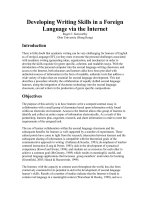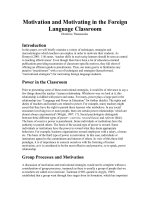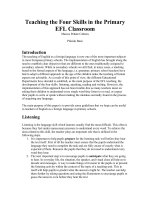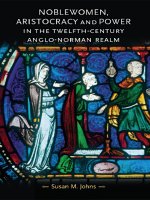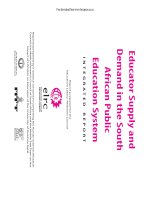Motivation and Motivating in the Foreign Language Classroom
Bạn đang xem bản rút gọn của tài liệu. Xem và tải ngay bản đầy đủ của tài liệu tại đây (109.33 KB, 7 trang )
Motivation and Motivating in the Foreign
Language Classroom
Dimitrios Thanasoulas
Introduction
In this paper, we will briefly examine a variety of techniques, strategies and
macrostrategies which teachers can employ in order to motivate their students. As Dornyei
(2001: 116) notes, ‘teacher skills in motivating learners should be seen as central to
teaching effectiveness'. Even though there have been a lot of education-oriented
publications providing taxonomies of classroom-specific motives, they fall short of
offering an efficient guide to practitioners. Thus, our main goal is to familiarise any
putative “practitioners” with a set of techniques and strategies (henceforward,
“motivational strategies”) for motivating foreign language students.
Power in the Classroom
Prior to presenting some of these motivational strategies, it would be of relevance to say a
few things about the teacher / learner relationship. Whichever way we look at it, this
relationship is riddled with power and status. For many, power plays a large part in the
relationship (see “Language and Power in Education” for further details). The rights and
duties of teachers and learners are related to power. For example, many teachers might
assert that they have the right to punish those learners who misbehave. In any social
encounter involving two or more people, there are certain power relationships ‘which are
almost always asymmetrical' (Wright, 1987: 17). Social psychologists distinguish between
three different types of power—coercive, reward-based, and referent (ibid.). The basis of
coercive power is punishment. Some individuals or institutions have the authority to punish
others. The basis of the second type of power is reward. Some individuals or institutions
have the power to reward what they deem appropriate behaviour. For example, business
organisations reward employees with a salary, a bonus etc. The basis of the third type of
power is motivation. In this case, individuals or institutions appeal to the commitment and
interest of others. In view of this three-fold paradigm, it is of importance to concern
ourselves with the fostering of learner motivation, as it is considered to be the most
effective and proactive, so to speak, power relationship.
Group Processes and Motivation
A discussion of motivation and motivational strategies would not be complete without a
consideration of group processes, inasmuch as there is usually a group of people that we as
teachers are called on to motivate. Tuckman (1969, quoted in Argyle, 1969) established
that a group went through four stages from its formation, which has important implications
for the study of the classroom and the use of group activities during teaching.
• Stage 1 Forming : At first, there is some anxiety among the members of the group,
as they are dependent on the leader (that is, the teacher) and they have to find out
what behaviour is acceptable.
• Stage 2 Storming : There is conflict between sub-groups and rebellion against the
leader. Members of the group resist their leader and the role relations attending the
function of the group are questioned.
• Stage 3 Norming : The group begins to develop a sort of cohesion. Members of the
group begin to support each other. At this stage, there is co-operation and open
exchange of views and feelings about their roles and each other.
• Stage 4 Performing : Most problems are resolved and there is a great deal of
interpersonal activity. Everyone is devoted to completing the tasks they have been
assigned.
Experience shows that almost every group goes through these four (or even more) stages
until it reaches equilibrium and, thus, taps into its potential. In reality, this process may go
on forever, since student lethargy and underachievement norms in the classroom are
considered to be basic hindrances to effective teaching and learning (Daniels, 1994).
Against this background, we will try to design a framework for motivational strategies.
A Framework for Motivational Strategies
As we have already said, skill in motivating students to learn is of paramount importance.
Until recently, however, teachers were forced to rely on “bag-of-tricks” approaches in their
attempt to manage their classroom and motivate their learners. Good and Brophy (1994:
212) hold that these approaches have been influenced by two contradictory views:
• a)that learning should be fun and that any motivation problems that may appear
should be ascribed to the teacher's attempt to convert an enjoyable activity to
drudgery; and
• b)that school activities are inherently boring and unrewarding, so that we must rely
on extrinsic rewards and punishment with a view to forcing students to engage in
these unpleasant tasks.
Rewards and punishments may be a mainstay of the teaching-learning process, but they are
not the only tools in teachers' arsenal. Dornyei (2001: 119) believes that ‘the spectrum of
other potentially more effective motivational strategies is so broad that it is hard to imagine
that none of them would work'.
The central question in designing a framework of motivational strategies is to decide how
to organise them into separate themes. The following taxonomy, around which our main
discussion will revolve, is based on the process-oriented model by Dornyei and Otto
(1998). The key units in this taxonomy are as follows:
• Creating the basic motivational conditions, which involves setting the scene for the
use of motivational strategies;
• Generating student motivation, which roughly corresponds to the preactional phase
in the model;
• Maintaining and protecting motivation, which corresponds to the actional phase;
• Encouraging positive self-evaluation, which corresponds to the postactional phase
Creating the Basic Motivational Conditions
Motivational strategies cannot work in a vacuum. There are certain preconditions to be met
before any attempts to generate motivation can be effective. Some of these conditions are
the following:
• a) appropriate teacher behaviour and good teacher-student rapport;
• b) a pleasant and supportive classroom atmosphere;
• c) a cohesive learner group characterised by appropriate group norms
Appropriate Teacher Behaviour and Good Teacher-
student Rapport
Whatever is done by a teacher has a motivational, formative, influence on students. In other
words, teacher behaviour is a powerful ‘motivational tool' (Dornyei, 2001: 120). Teacher
influences are manifold, ranging from the rapport with the students to teacher behaviours
which “prevail upon” and / or “attract” students to engage in tasks. For Alison (1993), a
key element is to establish a relationship of mutual trust and respect with the learners, by
means of talking with them on a personal level. This mutual trust could lead to enthusiasm.
At any rate, enthusiastic teachers impart a sense of commitment to, and interest in, the
subject matter, not only verbally but also non-verbally—cues that students take from them
about how to behave.
A Pleasant and Supportive Classroom Atmosphere
It stands to reason that a tense classroom climate can undermine learning and demotivate
learners (see MacIntyre, 1999 and Young, 1999 for further details). On the other hand,
learner motivation will reach its peak in a safe classroom climate in which students can
express their opinions and feel that they do not run the risk of being ridiculed.
To be motivated to learn, students need both ample opportunites to learn and steady
encouragement and support of their learning efforts. Because such motivation is unlikely to
develop in a chaotic classroom, it is important that the teacher organise and manage the
classroom as an effective learning environment. Furthermore, because anxious or alienated
students are unlikely to develop motivation to learn, it is important that learning occurs
within a relaxed and supportive atmosphere (Good and Brophy, 1994: 215).
A Cohesive Learner Group Characterised by
Appropriate Group Norms
As was hinted at above, fragmented groups, characterised by lack of cooperativeness, can
easily become ineffective, thus reducing the individual members' commitment to learn.
There are several factors that promote group cohesiveness, such as the time spent together
and shared group history, learning about each other, interaction, intergroup competition,
common threat, active presence of the leader […] (see Ehrman and Dornyei, 1998: 142).
As for group norms, they should be discussed and adopted by members, in order to be
constructive and long-lasting. If a norm mandated by a teacher fails to be accepted as
proper by the majority of the class members, it will not become a group norm.
Generating Student Motivation
Ideally, all learners exhibit an inborn curiosity to explore the world, so they are likely to
find the learning experience per se instrinsically pleasant. In reality, however, this
“curiosity” is weakened by such inexorable factors as compulsory school attendance,
curriculum content, and grades—most importantly, the premium placed on them.
Apparently, unless teachers increase their learners' ‘goal-orientedness', make curriculum
relevant for them, and create realistic learner beliefs, they will come up against a classroom
environment fraught with lack of cohesiveness and rebellion.
Increasing the Learners' ‘Goal-Orientedness'
In an some classes, many, if not most, students do not understand why they are involved in
an activity. It may be the case that the goal set by outsiders (i.e., the teacher or the
curriculum) is far from being accepted by the group members. Thus, it would seem
beneficial to increase the group's goal-orientedness, that is, the extent to which the group
tunes in to the pursuit of its official goal. This could be achieved by allowing students to
define their own personal criteria for what should be a group goal.
Making the Curriculum Relevant for the Learners
Many students do their homework and engage in many types of learning activities, even
when a subject is not very interesting. Obviously, these students share the belief of the
curriculum makers that what they are being taught will come in handy. In order to inspire
learners to concern themselves with most learning activities, we should find out their goals
and the topics they want to learn, and try to incorporate them into the curriculum.
According to Chambers (1999: 37), ‘[i]f the teacher is to motivate pupils to learn, then
relevance has to be the red thread permeating activities'.
Creating Realistic Learner Beliefs
It is widely acknowledged that learner beliefs about how much progress to expect, and at
what pace, can, and do, lead to disappointment. Therefore, it is important to help learners
get rid of their preconceived notions that are likely to hinder their attainment. To this end,
learners need to develop an understanding of the nature of second language learning, and
should be cognisant of the fact that the mastery of L2 can be achieved in different ways,
using a diversity of strategies, and a key factor is for learners to discover for themselves the
optimal methods and techniques.
Maintaining and Protecting Motivation
Unless motivation is sustained and protected when action has commenced, the natural
tendency to get tired or bored of the task and succumb to any attractive distractions will
result in demotivation. Therefore, there should be a motivational repertoire including
several motivation maintenance strategies. Let us have a look at two of them: a) increasing
the learners' self-confidence; and b) creating learner autonomy.
Increasing the Learners' Self-confidence
In an inherently face-threatening context, as the language classroom is likely to be, it is
important to find out how to maintain and increase the learners' self-confidence. There are
five approaches that purport to help to this end (Dornyei, 2001: 130):
• Teachers can foster the belief that competence is a changeable aspect of
development
• Favourable self-conceptions of L2 competence can be promoted by providing
regular experiences of success
• Everyone is more interested in a task if they feel that they make a contribution
• A small personal word of encouragement is sufficient
• Teachers can reduce classroom anxiety by making the learning context less
stressful
Creating Learner Autonomy
Many educationists and researchers (Benson, 2000; Little, 1991; Wenden, 1991; also see
my article, “What is Learner Autonomy and How can it be Fostered?”) argue that taking
charge of one's learning, that is, becoming an autonomous learner, can prove beneficial to
learning. This assumption is premised on humanistic psychology, namely that ‘the only
kind of learning which significantly affects behaviour is self-discovered, self-appropriated
learning' (Rogers, 1961: 276). Benson (2000, found in Dornyei, 2001: 131) distinguishes
between five types of practice fostering the development of autonomy:
• resource-based approaches, which emphasise independent interaction with learning
materials
• technology-based approaches, which emphasise independent interaction with
educational technologies
• learner-based approaches, which emphasise the direct production of behavioural
and psychological changes in the learner
• classroom-based approaches, which emphasise changes in the relationship between
learners and teachers in the classroom
